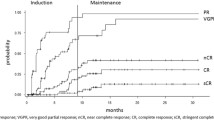Abstract
Introduction and Objective
The management of elderly patients with multiple myeloma is a relevant problem because it concerns a great number of patients. Patients with multiple myeloma who are very old or who have severe associated diseases have a dismal outcome. For these patients we retrospectively evaluated the effect of a mild approach with continuous low-dose melphalan and prednisone (cMP).
Design and Methods
109 patients with multiple myeloma, observed between 1985 and 2000, were treated with cMP; 67 were treated at time of diagnosis (group A; median age 78 years) and 42 as a second or subsequent line of therapy (group B; median age 72 years). The toxicity of the treatment was compared with a control group of 29 patients aged over 70 years, treated in the same institution with the conventional cyclical melphalan/prednisone regimen.
Results
Major or minor responses were obtained in 32% of patients in group A and 13% of patients in group B. Disease was stabilised in 45% of group A and 47% of group B and progressed in 5 and 18%, respectively. Median survival was, respectively, 19 and 24 months in group A and B.
Among the 42 patients who received cMP as a second-line therapy (group B), 36 (86%) had previously been treated according to the standard cyclical melphalan/prednisone schedule; of these 12 (33%) obtained a better M protein reduction after cMP compared with the previous response to first-line cyclical melphalan/prednisone.
The cMP schedule was generally well tolerated, and the rate of haematological toxicity was lower than for a historical control group receiving cyclical melphalan/prednisone.
Conclusion
The cMP treatment schedule is well tolerated and results in a high proportion of patients with stable disease, with acceptable survival even in patients with advanced disease.






Similar content being viewed by others
References
Cohen HJ, Bartolucci A. Age and treatment of multiple myeloma. Southern Cancer Study Group Experience. Am J Med 1985; 79: 316–26
Attal MD, Huguet S, Schlaifer D, et al. A prospective randomized trial of autologous bone marrow transplantation and chemotherapy in multiple myeloma. N Engl J Med 1996; 335: 91–7
Jagannath S, Vesole DH, Glenn L, et al. Low risk intensive therapy for multiple myeloma with combined autologous bone marrow and blood stem support. Blood 1992; 80: 1666–72
Barlogie B, Jagannath S, Vesole D, et al. Autologous and allogenic transplants for multiple myeloma. Semin Hematol 1995; 32: 31–44
Gahrton G, Tura S, Ljungman P, et al. Allogenic bone marrow transplantation in multiple myeloma. N Engl J Med 1991; 325: 1267–73
Barlogie B, Zangari M, Spencer T, et al. Thalidomide in the management ofmultiple myeloma. Semin Hematol 2001; 38(3): 250–9
Rajkumar SV, Kyle RA. Thalidomide in the treatment of plasma cells malignancies. J Clin Oncol 2001; 19(16): 3592–5
Rodon P, Linassier C, Gauvain JB, et al. Multiple myeloma in elderly patients: presenting features and outcome. Eur J Haematol 2001; 66(1): 11–7
Kyle RA. The role of high dose chemotherapy in the treatment of multiple myeloma: a controversy. Ann Oncol 2000; 11 Suppl. 1: 55–8
Kyle RA. Management of patients with multiple myeloma: emphasizing the role of high-dose therapy. Clin Lymphoma 2001; 2(1): 21–8
Oken MM. Standard treatment of multiple myeloma. Mayo Clin Proc 1994; 69: 781–6
Gregory WM, Richards MA, Malpas JS. Combination chemotherapy versus melphalan and prednisolone in the treatment of multiple myeloma: an overview of published trials. J Clin Oncol 1992; 10(2): 334–42
Cuzick J, Erskine S, Edelman D, et al. A comparison of the incidence of the myelodysplastic syndrome and acute myeloid leukaemia following melphalan and cyclophosphamide treatment for myelomatosis. Br J Cancer 1987; 55: 523–9
Oken MM, Tsiatis A, Ambramson N, et al. Comparison of standard (MP) with intensive (VMCP) therapy for the treatment of multiple myeloma [abstract]. Proc Am Soc Clin Oncol 1984; 3: 270
Oken MM, Harrington DP, Abramson MD, et al. Comparison of melphalan and prednisone with vincristine, carmustine, melphalan, ciclophosphamide and prednisone in the treatment of multiple myeloma. Results of Eastern Cooperative Oncology Group Study. Cancer 1997; 79: 1562–7
Durie BGM, Salmon SE. A clinical staging system for multiple myeloma. Cancer 1975; 36: 842–54
Kaplan EL, Meier P. Non parametric estimation from incomplete observations. J Am Stat Assoc 1958; 53: 457–81
Singhal S, Mehta J, Desikan R, et al. Antitumor activity of thalidomide in refractory multiple myeloma. N Engl J Med 1999; 341(21): 1565–71
Dimopoulos MA, Zervas K, Kouvatseas G, et al. Thalidomide and dexamethasone combination for refractory multiple myeloma. Ann Oncol 2001; 12(7): 991–5
Barlogie B, Desikan R, Eddlemon S, et al. Extended survival in advanced and refractory multiple myeloma after singleagent thalidomide: identification of prognostic factors in a phase 2 study of 109 patients. Blood 2001; 98(2): 492–4
The Myeloma Trialists’ Collaborative Group. Combination chemotherapy versus melphalan plus prednisone as treatment for multiple myeloma: an overview of 6633 patients from 27 randomised trials. J Clin Oncol 1998; 12: 3832–42
Manoharan A. Gentle yet effective treatment for elderly patients with refractory or relapsing multiple myeloma. Am J Hematol 2000; 65: 81–2
Acknowledgements
We thank Professor Giuseppe Avvisati (Università Campus Bio-Medico, Roma) for his useful suggestions and his critical review of the manuscript. The study was supported by Associazione Italiana contro le Leucemie. No potential conflicts of interest exist between the authors and the contents of this study.
Author information
Authors and Affiliations
Corresponding author
Rights and permissions
About this article
Cite this article
Pulsoni, A., Villivà, N., Cavalieri, E. et al. Continuous Low Dose of Melphalan and Prednisone in Patients with Multiple Myeloma of Very Old Age or Severe Associated Disease. Drugs Aging 19, 947–953 (2002). https://doi.org/10.2165/00002512-200219120-00005
Published:
Issue Date:
DOI: https://doi.org/10.2165/00002512-200219120-00005




